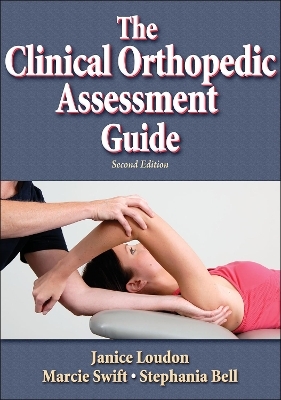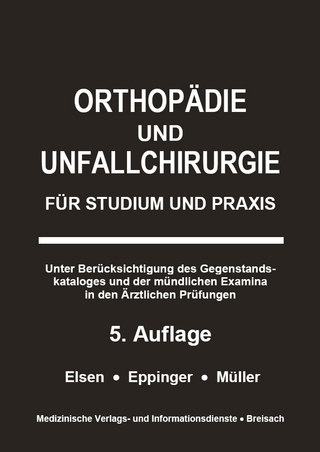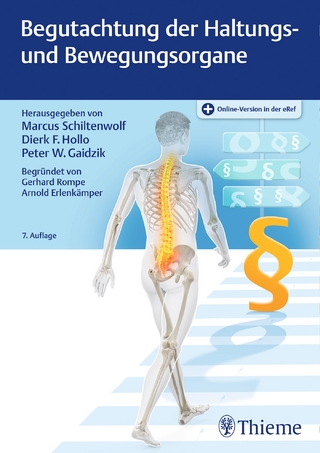
The Clinical Orthopedic Assessment Guide
Human Kinetics (Verlag)
978-0-7360-6709-6 (ISBN)
- Titel ist leider vergriffen;
keine Neuauflage - Artikel merken
The Clinical Orthopedic Assessment Guide, Second Edition, is the foremost reference for comprehensive patient assessment. Conveniently packaged and competitively priced, it provides techniques for accurate patient assessment and functional information about normal and abnormal static and dynamic motions. This second edition has been reformatted with a smaller size, streamlined content, and lay-flat binding to be a practical addition to your collection.
Like the previous edition, the text takes a regional approach but now also includes material on the upper cervical spine, pelvis, and sacroiliac joint and information on the assessment of peripheral nerve injury and treatment techniques (adverse neurodynamics). In addition, the overall design and layout have been overhauled to make this resource even more user friendly and visually appealing. A more compact size makes it easier to transport or attach to a clipboard. A special binding allows clinicians to lay the book open on a flat surface without damaging the text's spine. Almost all illustrations have been converted to photos, and the quantity of photos has increased significantly. For clarity, many of the photos are enhanced with arrows showing direction of movement or highlighting specific elements. And finally, for easy recognition, special symbols have been added to the top of test and measurement pages so information can be located with a quick flip through the pages.
The streamlined organization of The Clinical Orthopedic Assessment Guide, Second Edition, makes it simple to find the information you need. The book flows through a regional presentation of clinical assessments and functional tests (including 40 new tests that were not featured in the first edition), a section on gait and posture, and a new section on adverse neurodynamics. The regional sections are further broken down into specific joints, and each joint-specific chapter follows a common layout so you can easily find exactly what you need:
-A description of joint basics, arthrokinematics, and neurology
-Surface palpation, muscle origin and insertion, and muscle action and innervation
-Subjective and objective examination sequences
-Clinical syndrome tables to assist with musculoskeletal differential diagnosis
Additionally, a suggested examination sequence for the history and test and measures is provided for each peripheral and spinal joint. Many of the tests are also accompanied with sensitivity and specificity values to help determine test utility.
Essential information regarding regional assessments and whole-body mechanical functions will be at your fingertips with The Clinical Orthopedic Assessment Guide, Second Edition. Keep this convenient reference close at hand to help you perform accurate assessments that will lead to proper diagnosis and care of patient injuries.
Janice Loudon, PhD, is an associate professor in the department of physical therapy and rehabilitation science at the University of Kansas Medical Center in Kansas City. She teaches courses in applied kinesiology and biomechanics, applied musculoskeletal anatomy, evaluation methods, and principles of treatment of musculoskeletal disorders, health promotion, and musculoskeletal rehabilitation. Loudon is a licensed physical therapist and licensed athletic trainer in Missouri and Kansas, an athletic trainer certified by the National Athletic Trainers' Association, and a sport specialist certified by the American Physical Therapy Association. In January 2002 she completed a mentorship program with the Kaiser Hayward physical therapy residency in advanced orthopedic manual therapy. Loudon is also a certified manual therapist; she completed the level 1 residency program in manual therapy at the Ola Grimsby Institute in 1997. As an author and researcher, Loudon has produced more than 40 publications as well as the first edition of The Clinical Orthopedic Assessment Guide. She serves as a reviewer for several journals and is a member of the editorial board for Journal of Athletic Training, Journal of Sport Rehabilitation, and the Journal of Orthopaedic and Sports Physical Therapy. Loudon is a member of the American Physical Therapy Association, the National Athletic Trainers' Association, and the National Strength and Conditioning Association. She lives in Overland Park, Kansas, and enjoys jogging, biking, and golfing. Stephania Bell, MS, PT, is a clinical assistant professor in physical therapy education at the University of Kansas Medical Center. Bell teaches advanced orthopedics and provides clinical services at the medical center's Sports Medicine Institute. In 1997, she completed a two-year program leading to certification in orthopedic manual therapy through the Ola Grimsby Institute. Bell is a member of the American Academy of Orthopedic Manual Physical Therapists and the American Physical Therapy Association. Marcie Swift, PhD, is a clinical assistant professor in the department of physical therapy and rehabilitation sciences at the University of Kansas Medical Center in Kansas City. Swift received her PhD in rehabilitation science from the University of Kansas Medical Center in 2007. She has also completed both a fellowship program and a mentorship program in orthopedic manual physical therapy at the Kaiser Permanente physical therapy residency in advanced orthopedic manual therapy. In addition to her academic and clinical responsibilities, Swift teaches courses in musculoskeletal physical therapy and applied musculoskeletal anatomy.
Part I. Introduction to Biomechanical Principles
Chapter 1. Classifications and Definitions
Joint Basics
Arthrokinematics
Neurology
Surface Palpation
Muscle Origin and Insertion
Muscle Action and Innervation
Differential Diagnosis
Clinical Syndromes
Chapter 2. Examination Sequence for History and Tests and Measures
Patient Profile
Symptom Description—Location and Type
Behavior of Symptoms
Special Questions
History of the Current Episode
Previous History
Part II. Head and Spine
Chapter 3. Temporomandibular Joint
Joint Basics
Arthrokinematics
Neurology
Surface Palpation
Muscle Origin and Insertion
Muscle Action and Innervation
Differential Diagnosis
Clinical Syndromes
Chapter 4. Cervical Spine
Joint Basics
Arthrokinematics
Neurology
Surface Palpation
Muscle Origin and Insertion
Muscle Action and Innervation
Subjective Examination
Objective Examination
Examination Sequence
Differential Diagnosis
Subjective Examination Sequence
Objective Examination Sequence
Clinical Syndromes
Chapter 5. Thoracic Spine
Joint Basics
Arthrokinematics
Neurology
Surface Palpation
Muscle Origin and Insertion
Muscle Action and Innervation
Subjective Examination
Objective Examination
Differential Diagnosis
Subjective Examination Sequence
Objective Examination Sequence
Clinical Syndromes
Chapter 6. Lumbar Spine
Joint Basics
Arthrokinematics
Neurology
Surface Palpation
Muscle Origin and Insertion
Muscle Action and Innervation
Subjective Examination
Objective Examination
Differential Diagnosis
Subjective Examination Sequence
Objective Examination Sequence
Clinical Syndromes
Chapter 7. Pelvis
Joint Basics
Arthrokinematics
Neurology
Surface Palpation
Muscle Origin and Insertion
Muscle Action and Innervation
Subjective Examination
Objective Examination
Differential Diagnosis
Subjective Examination Sequence
Objective Examination Sequence
Clinical Syndromes
Part III. Upper Extremity
Chapter 8. Shoulder Joint Complex
Joint Basics
Glenohumeral Joint
Sternoclavicular Joint
Acromioclavicular Joint
Scapulothoracic Joint
Arthrokinematics
Neurology
Surface Palpation
Muscle Origin and Insertion
Muscle Action and Innervation
Subjective Examination
Objective Examination
Differential Diagnosis
Subjective Examination Sequence
Objective Examination Sequence
Clinical Syndromes
Chapter 9. Elbow and Forearm
Joint Basics
Humeroulnar joint
Humeroradial joint
Superior Radioulnar joint
Distal Radioulnar joint
Arthrokinematics
Neurology
Surface Palpation
Muscle Origin and Insertion
Muscle Action and Innervation
Subjective Examination
Objective Examination
Differential Diagnosis
Subjective Examination Sequence
Objective Examination Sequence
Clinical Syndromes
Chapter 10. Wrist and Hand
Joint Basics
Radiocarpal Joint
Midcarpal Joint
Carmpometacarpal Joint (CMC, 2 to 5)
Arthrokinematics of the Wrist Complex
Metacarpal Joints (MCP, 2 to 5)
Proximal Interphalangeal Joints (PIP, 2 to 5)
Distal Interphalangeal Joints (DIP, 2 to 5)
Arthrokinematics of the Fingers
Thumb Carpometacarpal Joints
Thumb Metacarpal Joints
Arthrokinematics of the Thumb
Arthrokinematics
Neurology
Surface Palpation
Muscle Origin and Insertion
Muscle Action and Innervation
Subjective Examination
Objective Examination
Differential Diagnosis
Subjective Examination Sequence
Objective Examination Sequence
Clinical Syndromes
Chapter 11. Functional Assessment of the Upper Extremity
Shoulder
Elbow
Wrist, Hand, and Grip
Throwing Mechanics
Part IV. Lower Extremity
Chapter 12. Hip Joint
Joint Basics
Arthrokinematics
Neurology
Surface Palpation
Muscle Origin and Insertion
Muscle Action and Innervation
Subjective Examination
Objective Examination
Differential Diagnosis
Subjective Examination Sequence
Objective Examination Sequence
Clinical Syndromes
Chapter 13. Knee
Joint Basics
Tibiofemoral Joint
Proximal Tibiofibular Joint
Patellofemoral Joint
Arthrokinematics
Neurology
Surface Palpation
Muscle Origin and Insertion
Muscle Action and Innervation
Subjective Examination
Objective Examination
Differential Diagnosis
Subjective Examination Sequence
Objective Examination Sequence
Clinical Syndromes
Chapter 14. Foot and Ankle
Joint Basics
Distal Tibiofibular Joint (DTF)
Talocrural Joint (TC)
Subtalar Joint (STJ)
Transtarsal Joint (Joint of Chopart, Midtarsal Joint)
Midfoot
Forefoot (Tarsometatarsal Joint)
Metatarsophalangeal Joints (MTP)
Interphalangeal Joints (IP)
Arthrokinematics
Neurology
Surface Palpation
Muscle Origin and Insertion
Muscle Action and Innervation
Subjective Examination
Objective Examination
Differential Diagnosis
Subjective Examination Sequence
Objective Examination Sequence
Clinical Syndromes
Chapter 15. Functional Testing of the Lower Extremity
Muscle Imbalances
Functional Strength Testing of the Hip
Functional Strength Testing of the Knee
Functional Strength Testing of the Foot and Ankle
Part V. Posture and Gait
Chapter 16. Posture
Terminology
Ideal Posture
Chapter 17. Gait
Terminology
Gait Sequence
Gait Sequence With Joint Position and Muscle Activity
Range of Motion Needed During Gait
Gait Disturbances and Mechanical Faults
Chapter 18. Running Gait
Running
Shoe Wear
Shoe Shape
Stair Climbing
Part VI. Adverse Neurodynamics
Chapter 19. Upper-Extremity and Lower-Extremity Neurodynamics
Historical Background
Anatomy
Pathology
Objective Examination Sequence
| Erscheint lt. Verlag | 13.5.2008 |
|---|---|
| Verlagsort | Champaign, IL |
| Sprache | englisch |
| Maße | 178 x 254 mm |
| Gewicht | 771 g |
| Themenwelt | Medizinische Fachgebiete ► Chirurgie ► Unfallchirurgie / Orthopädie |
| Studium ► 2. Studienabschnitt (Klinik) ► Anamnese / Körperliche Untersuchung | |
| ISBN-10 | 0-7360-6709-4 / 0736067094 |
| ISBN-13 | 978-0-7360-6709-6 / 9780736067096 |
| Zustand | Neuware |
| Haben Sie eine Frage zum Produkt? |
aus dem Bereich


